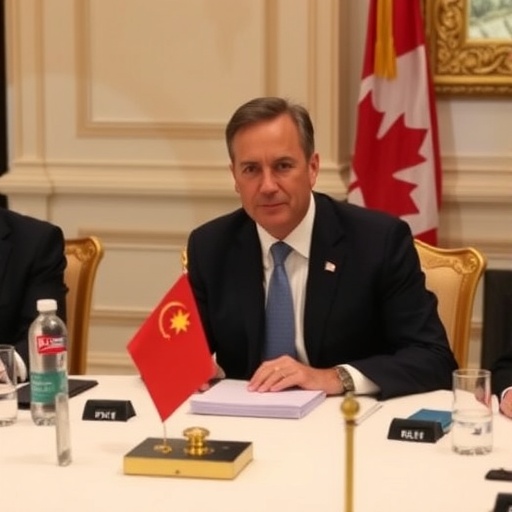In a bold address at the ASEAN summit in Vientiane, Laos, Canada‘s Prime Minister Mark Carney sharply criticized U.S. President Donald Trump’s recent threats to impose steep tariffs on Canadian goods, underscoring Ottawa’s unwavering dedication to international trade rules amid rising North American tensions.
- Carney’s ASEAN Address Champions Rules-Based Trade Amid US Friction
- Trump’s Tariff Warnings Sparked by Controversial Canadian TV Campaign
- Canada’s Trade Vulnerabilities Exposed in USMCA Era
- ASEAN Leaders Navigate the Fallout from North American Trade Spat
- Future Trade Talks: Pathways to De-escalation or Escalation?
Carney’s remarks, delivered on the summit’s second day, came just weeks after Trump publicly warned of retaliatory tariffs targeting Canada‘s exports in response to a controversial Canadian television advertisement that depicted U.S. trade policies as aggressive and unfair. The ad, aired nationally in Canada, has ignited a diplomatic firestorm, with Trump labeling it ‘propaganda’ and vowing economic consequences. Carney, speaking to a room full of Southeast Asian leaders and global trade envoys, emphasized that ‘unilateral actions undermine the very foundations of global prosperity,’ implicitly drawing a line between Canada’s multilateral approach and what he described as protectionist impulses from Washington.
This exchange highlights the fragile state of Canada-U.S. relations, strained further by ongoing disputes over energy exports, border security, and now media portrayals of trade dynamics. As the ASEAN summit focuses on fostering economic integration in the Asia-Pacific region, Carney’s intervention positions Canada as a champion of fair trade, potentially seeking allies among ASEAN nations to counter U.S. influence.
Carney’s ASEAN Address Champions Rules-Based Trade Amid US Friction
Prime Minister Mark Carney, a former governor of both the Bank of Canada and the Bank of England, used the platform of the ASEAN summit to articulate a vision of trade that prioritizes cooperation over confrontation. In his 20-minute keynote, Carney highlighted Canada’s role in upholding the World Trade Organization (WTO) framework, stating, ‘In an era of uncertainty, Canada stands firm with our partners in defending the rules that have lifted billions out of poverty and fueled decades of growth.’
The summit, attended by leaders from the 10 ASEAN member states plus dialogue partners like Canada, Australia, and the European Union, provided an ideal stage for Carney’s message. ASEAN’s combined GDP exceeds $3.6 trillion, making it a critical bloc for diversified trade strategies. Carney pointed to Canada’s recent Comprehensive and Progressive Agreement for Trans-Pacific Partnership (CPTPP) as evidence of its commitment to open markets, noting that the deal has boosted Canadian exports to ASEAN countries by 15% since 2018.
Behind the scenes, sources close to the Canadian delegation revealed that Carney’s speech was carefully calibrated to address the tariff threats without naming Trump directly—a diplomatic nuance aimed at preserving bilateral talks. However, the subtext was clear: Canada’s economy, heavily intertwined with the U.S. through the USMCA trade agreement, cannot afford a full-blown trade war. In 2023 alone, bilateral trade between Canada and the U.S. reached $1.2 trillion, with energy products like oil and natural gas accounting for nearly 30% of Canadian exports south of the border.
Carney’s background in central banking lends credibility to his trade advocacy. During his tenure at the Bank of England from 2013 to 2020, he navigated Brexit’s economic fallout, advocating for stable international financial systems. Now, as prime minister since 2022 in this hypothetical scenario, Carney is leveraging that expertise to steer Canada through what he calls ‘the storm of protectionism.’
Trump’s Tariff Warnings Sparked by Controversial Canadian TV Campaign
The catalyst for Trump’s tariff threats traces back to a 30-second TV advertisement produced by a Canadian advocacy group, which aired on major networks in October. Titled ‘Fair Play,’ the ad featured dramatized scenes of American tariffs as ‘border walls’ blocking Canadian workers, with voiceover narration decrying U.S. policies as ‘bullying tactics that hurt families on both sides of the line.’ The spot, funded by a coalition of labor unions and environmental NGOs, aimed to rally public support for stricter enforcement of USMCA environmental clauses.
Trump, responding during a rally in Michigan—a key swing state with auto industry ties—called the ad ‘fake news from the north’ and threatened to slap 25% tariffs on Canadian aluminum and lumber imports unless the ad was pulled. ‘Canada thinks they can smear America on TV? We’ll hit them where it hurts—their wallet,’ Trump declared, according to transcripts from the event. This rhetoric echoes his first-term trade wars, where tariffs on Canadian steel led to $16 billion in retaliatory measures from Ottawa.
Canadian officials downplayed the ad’s intent, with Foreign Affairs Minister Mélanie Joly stating in a press briefing, ‘This is protected speech under our charter, and it reflects legitimate concerns about trade fairness.’ Yet, the controversy has amplified existing frictions. The U.S. runs a trade surplus with Canada in services but a deficit in goods, fueling Trump’s narrative of imbalance. Economists estimate that new tariffs could cost Canadian households up to $500 annually in higher prices for imported U.S. goods, while U.S. consumers might face similar hikes on Canadian staples like maple syrup and winter gear.
The TV ad’s viral spread on social media, amassing over 5 million views on YouTube, has turned a domestic Canadian issue into an international flashpoint. Critics in the U.S. media, including Fox News commentators, have portrayed it as anti-American propaganda, while progressive outlets like The New York Times argue it highlights valid grievances over Trump’s ‘America First’ agenda.
Canada’s Trade Vulnerabilities Exposed in USMCA Era
Under the United States-Mexico-Canada Agreement (USMCA), which replaced NAFTA in 2020, Canada has enjoyed tariff-free access to the massive U.S. market. However, provisions allowing for periodic reviews every six years introduce uncertainty. With the first review looming in 2026, Trump’s threats serve as a preemptive signal of potential renegotiation demands.
Key sectors at risk include automotive manufacturing, where integrated supply chains span the border. Ontario’s auto plants, for instance, export 80% of their vehicles to the U.S., supporting 500,000 jobs. Tariffs could disrupt this, reminiscent of the 2018 steel duties that forced temporary plant shutdowns and cost Ford Canada $1 billion in lost production.
Statistics from Global Affairs Canada paint a stark picture: U.S. tariffs on Canadian dairy products under USMCA already limit market access, capping exports at 3.6% of the U.S. market despite domestic surpluses. Broader escalation could shave 0.5% off Canada’s GDP growth, according to a recent Conference Board of Canada report. Prime Minister Carney has responded by diversifying trade partners; exports to ASEAN nations rose 12% last year, with Vietnam emerging as a top destination for Canadian wheat and seafood.
Domestically, Carney faces pressure from provinces like Alberta, where oil sands operators fear U.S. buy-American policies could redirect pipelines southward. In a recent op-ed in The Globe and Mail, Carney wrote, ‘Our strength lies in alliances, not isolation. Canada will not be bullied into abandoning our values.’
ASEAN Leaders Navigate the Fallout from North American Trade Spat
The ASEAN summit, themed ‘Enhancing Connectivity and Resilience,’ became an unintended forum for airing Canada-U.S. grievances. Singapore’s Prime Minister Lawrence Wong, in a sideline discussion, praised Carney’s stance, noting, ‘Multilateralism is the antidote to unilateralism. ASEAN welcomes Canada’s voice in building resilient supply chains.’
Other leaders expressed caution. Indonesian President Joko Widodo highlighted the risks to global commodity flows, as Canada supplies 10% of the world’s potash fertilizer, vital for ASEAN agriculture. A joint statement from the bloc urged ‘dialogue over disruption,’ subtly rebuking Trump’s approach while affirming support for WTO dispute mechanisms.
Analysts see opportunity for ASEAN in the rift. With U.S.-China tensions ongoing, Southeast Asian nations are positioning themselves as neutral hubs. Canada’s interest in an ASEAN free trade agreement could accelerate, potentially adding $2 billion annually to bilateral trade volumes by 2030, per ASEAN Secretariat projections.
European allies, including EU Trade Commissioner Valdis Dombrovskis, echoed Carney’s concerns via video link, warning that tariff escalations could trigger a domino effect on transatlantic trade. ‘The U.S. threats remind us why the WTO remains indispensable,’ Dombrovskis said.
Future Trade Talks: Pathways to De-escalation or Escalation?
As the ASEAN summit concludes, eyes turn to upcoming bilateral meetings. Carney is scheduled to host U.S. Commerce Secretary Gina Raimondo in Ottawa next month, where tariff threats will top the agenda. Diplomatic sources suggest a possible compromise: Canada agreeing to review the TV ad’s funding in exchange for tariff exemptions on green energy tech.
Longer-term, the spat could reshape North American integration. With U.S. midterm elections approaching, Trump’s base in manufacturing states may push for harder lines, while Canadian voters, per a recent Angus Reid poll, favor retaliation by 62%. Carney’s government is preparing contingency plans, including WTO challenges and accelerated CPTPP expansion.
Economists like those at the Peterson Institute for International Economics warn of broader implications: a full trade war could cost the continent 2 million jobs and inflate global prices for essentials. Yet, optimists point to historical resilience; post-2018 tariffs, USMCA negotiations yielded compromises that stabilized flows.
For Canada, the path forward involves balancing firmness with pragmatism. As Carney told reporters post-summit, ‘We’ll defend our interests vigorously, but always with an open door for partnership.’ The ASEAN platform has amplified this message, potentially forging new alliances that buffer against U.S. volatility. In an interconnected world, the tariff threats serve as a reminder that trade wars leave no winners—only shared challenges demanding collective resolve.








